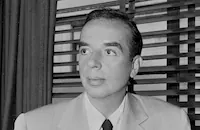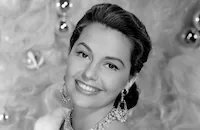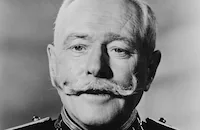Two Weeks in Another Town

Brief Synopsis
Cast & Crew
Vincente Minnelli
Kirk Douglas
Edward G. Robinson
Cyd Charisse
George Hamilton
Dahlia Lavi
Film Details
Technical Specs

Synopsis
Jack Andrus, a onetime Hollywood star whose sudden fall from stardom has led to alcoholism, divorce, a near-fatal automobile accident, and a nervous breakdown, spends 3 years in a New England sanatarium. Finally his doctors permit him to accept a small comeback role in a costume spectacle being directed by Maurice Kruger at Rome's Cinecitta Studios. Years before, Kruger had been the man responsible for Andrus' great success, but he too is now a Hollywood has-been, desperately trying to regain his lost reputation. Andrus arrives in Rome and learns that the part is no longer available, and, finding that the production is in serious trouble, reluctantly agrees to supervise the dubbing of the picture. In the evenings he soothes his wounded ego by relaxing in the company of an Italian woman named Veronica, who, unknown to Andrus, is in love with Kruger's young leading man, the rebellious Davie Drew. One night, following a fight with his shrewish wife Clara, Kruger suffers a heart attack and is hospitalized. Andrus offers to finish the film and, by working night and day, completes it ahead of schedule and under the budget. Simultaneously, he helps Davie sort out his confused life. Kruger, bitterly aware of his own failure, attacks Andrus and publicly accuses him of trying to steal the picture. Stricken, Andrus turns to his ex-wife, Carlotta, and goes on an orgiastic binge. Their night ends with a wild car ride that shocks Andrus into the realization that he cannot place his fate in the hands of others. Now strong and independent, he says goodby to Veronica and Davie and boards a plane for Hollywood.

Director

Vincente Minnelli
Cast

Kirk Douglas

Edward G. Robinson

Cyd Charisse

George Hamilton
Dahlia Lavi

Claire Trevor

James Gregory
Rosanna Schiaffino
Joanna Roos

George Macready
Mino Doro
Stefan Schnabel
Vito Scotti
Tom Palmer
Eric Von Stroheim Jr.
Leslie Uggams
Crew
Pierre Balmain
George W. Davis
Adrienne Fazan
Keogh Gleason
Henry Grace
Sydney Guilaroff
Charles K. Hagedon
Robert R. Hoag
John Houseman
Robert J. Kern Jr.
Milton Krasner
Urie Mccleary
Franklin Milton
Walter Plunkett
David Raksin
Charles Schnee
Eric Von Stroheim Jr.
William Tuttle
Ethel Winant

Photo Collections
Videos
Movie Clip





Trailer
Hosted Intro
Film Details
Technical Specs

Articles
Two Weeks in Another Town
In Two Weeks in Another Town (1962), Vincente Minnelli teams up again with the same composer (David Raksin), screenwriter (Charles Schnee), producer (John Houseman) and star (Kirk Douglas) with whom he had worked on the ultimate Hollywood melodrama, The Bad and the Beautiful (1952). This film even uses excerpts from the 1952 film to stand in for Kruger and Andrus' earlier collaboration. However, Two Weeks in Another Town is decidedly more bitter in tone, partly reflecting the decline in fortunes of the Hollywood film industry from the early Fifties to the early Sixties.
The writer Irwin Shaw (1913-1984), whose 1960 novel is the basis for this film, is perhaps best known today for the pulpy bestsellers Rich Man, Poor Man (1970) and Beggarman, Thief (1977), but he in fact had a remarkably diverse career. He first established his reputation as an innovative dramatist with plays such as the anti-war drama Bury the Dead (1936) and the Depression-era fable The Gentle People (1939); his work from this period links him to progressive-minded playwrights such as Clifford Odets. During the 1940s, Shaw turned mainly to the short story, where he produced what is arguably his most lasting work as a writer. Appearing in magazines such as The New Yorker, Collier's and Esquire and widely anthologized, his stories, many of them satirizing the empty materialism of affluent society, have become models for younger generations of short-story writers. Starting with The Young Lions (1948) Shaw's output shifted more to novels, although with mixed critical success.
In adapting it for the screen, screenwriter Charles Schnee and Minnelli made a number of significant changes to the novel, which is somewhat more loosely structured and rich with peripheral incidents and characters. The novel opens with Jack Andrus at the Orly airport in Paris with his French wife Helen and their children. In the film, Andrus' family has been removed altogether. In the novel, Andrus' acting career has been cut short due to a disfiguring accident during the war, but in the film it is due to a psychological breakdown. Also, in the novel Veronica's jealous lover is an American screenwriter and not an actor. In Shaw's story confronting the demons of his past allows Andrus to repair his relationship with his wife and children; in the film the overall thrust of the story has been shifted in the film to focus more on Jack Andrus' journey to emotional and creative self-sufficiency.
Another way in which Minnelli made the film his own was through its web of cinematic allusions, not least among them the clips from The Bad and the Beautiful. In particular, the Roman setting of the film is not just the locale of the novel, but it also deliberately echoes Fellini's La Dolce Vita (1960), especially the climactic orgy scene and the brief scene with the prostitutes gathering around cars in the park. Lastly, the film's examination of the lives of artists is prime Minnelli material, found also in films such as An American in Paris (1951), The Bad and the Beautiful, The Band Wagon (1953) and Lust for Life (1956).
Not surprisingly, the adult subject matter of the film ran into problems with the MPAA and the conservative studio executives at MGM. The difficulties behind the production are well documented in Stephen Harvey's excellent 1989 book Directed by Vincente Minnelli. Among the controversial elements were Andrus' affair with Veronica and an extended orgy sequence featuring off-screen lovemaking before a group of drunken onlookers. The new studio head, Joseph Vogel, wanted to transform the project into a "family film" and had it drastically re-edited. John Houseman, the film's producer, threatened to remove his name from the credits unless he had more control over what kinds of cuts were made and the overall shape of the film. While the finished product is hardly the "family film" that Vogel wanted, its impact was undeniably muted. In his 1988 autobiography The Ragman's Son Kirk Douglas writes: "I felt this was such an injustice to Vincente Minnelli, who'd done such a wonderful job with the film. And an injustice to the paying public, who could have had the experience of watching a very dramatic, meaningful film. They released it that way, emasculated." Two Weeks in Another Town was not well received by the critics or the public. Still, thanks to strong central performances by Kirk Douglas and Edward G. Robinson and Minnelli's stylish direction, the film is very much worth watching today. Look for a cameo by Leslie Uggams as a nightclub singer.
Director: Vincente Minnelli
Producer: John Houseman
Screenplay: Charles Schnee, based on the novel Two Weeks in Another Town (1960) by Irwin Shaw
Cinematography: Milton Krasner
Art Direction: George W. Davis, Urie McCleary
Editing: Adrienne Fazan, Robert J. Kern, Jr.
Music: David Raksin
Costumes: Pierre Balmain
Principal Cast: Kirk Douglas (Jack Andrus); Edward G. Robinson (Maurice Kruger); Cyd Charisse (Carlotta); George Hamilton (Davie Drew); Daliah Lavi (Veronica); Claire Trevor (Clara); Rosanna Schiaffino (Barzelli); Mino Doro (Tucino).
C-108m. Letterboxed. Closed captioning.
by James Steffen

Two Weeks in Another Town
Quotes
Trivia
Notes
Locations filmed in Rome. Scenes from The Bad and the Beautiful (M-G-M, 1952) are included. The film acknowledges the cooperation of the Academy of Motion Picture Arts and Sciences.

Miscellaneous Notes
Released in United States 1962
Cinemascope
Released in United States 1962















